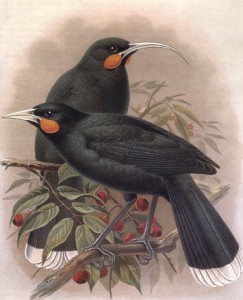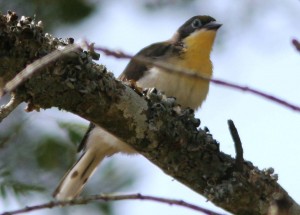What similarity is there between two species of birds, very different in many ways? They both cause major difficulties for evolutionists, and in their behaviour, exhibit forms of symbiosis that confound Darwinian natural selection. No explanation they offer has convinced me, look at the facts for yourself.
The Huia The Huia belonged to a family found only in New Zealand, a family so ancient that no relation is found elsewhere. Only the Moa and the Kiwi are likely to be older . Before the arrival of Europeans it was already a rare bird, confined to the mountain ranges in the south east of the North Island.
. Before the arrival of Europeans it was already a rare bird, confined to the mountain ranges in the south east of the North Island.
The Huia was a bird of deep metallic, bluish-black plumage with a greenish iridescence on the upper surface, especially about the head. The tail feathers were striking in having a broad white band across tips.
At the base of the bill, on either side of the mouth hung the fleshy wattles characteristic of the family Callaeidae, which were bright orange in the Huia. In both sexes the bill colour was ivory white and the legs were bluish grey. In size the Huia were slightly larger than the introduced Australian magpie.
But the most remarkable feature of the species was the marked difference in size and shape of the bill and this difference was so extreme to cause early ornithologists, such as the renowned John Gould, to think that the male and female belonged to different species.
The male’s bill was stout and about 6cm long and curved slightly downward while the female’s was slender, about 8.5 cm long, and very markedly curved downwards. The Huia relied mainly on insects for their food, especially those living in wood or under bark such as the abundant huhu beetle grub, Prionoplus reticularis. The male chiselled holes in the wood, but could not extract the grubs, and hence relied on the female, with her slender, curved beak, to feed them both. It is assumed that if either partner was carried away by some mishap, the remaining bird was liable to starve to death.
The Huia, above all other species in the forest, was sacred to the Maori. It was, according to one author, closely associated with the great chiefs of the land and only chiefs of distinction could properly wear its tail feathers. Also the head, beak and skinned birds were used as ear adornments, and the ancient war plume, marereko, consisted of twelve Huia feathers. The feathers, when not in use, were kept in ornately carved boxes called Waka Huia.
From the 1800’s, the ground dwelling birds were always prone to attack from rats, polecats, dogs and cats, all introduced to New Zealand by Europeans. However, the rewards offered by collectors, inciting the Maori to hunt the bird, which were sold to collectors in Europe and the United States.
Sir Walter Lawry Buller, New Zealand’s first ornithologist of note, who was deeply involved not only in the efforts to protect the bird but also in the trade of specimens to collectors, reports on one of his many expeditions in search of the Huia; “In the summer of 1867, accompanied by a friend and two natives, I made an expedition into the Ruahine ranges in search of novelties…. While thus engaged, we heard the soft flute–like note of the Huia in the wooded gully far beneath us. One of our native companions at once imitated the call and in a few seconds a pair of beautiful Huias, male and female, appeared on the branches near us. They remained gazing at us only a few instants and then started off up the side of the hill, moving by a succession of hops, often along the ground, the male generally leading. Waiting until he could get both birds in line, my friend at length pulled the trigger.”
However, the final reason the Huia is now extinct undoubtedly came with the visit to New Zealand of the Duke and Duchess of York at the turn of the century. At the great welcome given to the royal party at Rotorua by the Maori, one of the guides spontaneously removed the Huia feather from her own hair and placed it in the band of the bowler hat of the Duke. This simple act increased the demand for Huia feathers a hundredfold. Long after the royal guests had gone the demands for the feathers grew. Naturalists have cited the Huia’s specialized behaviour to explain their extinction. We know different.
The Honeyguide Across the bushlands of northern Kenya, a remarkable example of cooperation between bird and man can be found, operating today much as it has for untold  centuries, it was first described in 1567.
centuries, it was first described in 1567.
This is the territory of the Boran, a nomadic tribe who continue to subsist through hunting and gathering. For as long as they can remember, the Boran have been taking advantage of the helpful behaviour of a bird known as the greater honeyguide (Indicator indicator), which,as its name implies,is widely renowned as a guide towards choice deposits of honey. By nature the honeyguide displays a great fondness for beeswax and bee larvae. Inasmuch as beehives are virtually inaccessible to these birds and well protected by the African bees (Apis mellifira) themselves,the colonies are typically located in large trees, rock crevices or termite mounds,the honeyguide requires the aid of man in order to pillage the honey-cache.
As the natives tell it,and now confirmed by the study of Isack and Reyer, they summon the honeyguide to the campsite by emitting a specific, penetrating whistle which can be heard from a distance of over one kilometer. Upon hearing the whistle, the bird responds by flying towards the campsite of the Boran, whereupon it announces itself by flying close to the humans and moving restlessly amongst conspicuous perches in the trees, all the while emitting a very characteristic call (tirr-tirr-tirr-tirr). Once it has gained the attention of a potential honey-gatherer, the bird then proceeds to guide him to the site of the bee-colony, which may be several kilometres away. Alternately appearing and disappearing, the bird periodically returns to check on the humans, as if to make sure that they are still following, such returns becoming more frequent and agitated as the two parties get near to the hive. The Boran honey gatherers, in turn, whistle and bang sticks while following the bird to maintain its attention and announce their position. According to professional honey gatherers, “through its guiding pattern, the bird informs them about the direction of, the distance to, and their arrival at the colony.”
Upon arriving at the site of the bees’ nest, the honeyguide perches near it and emits a very characteristic “indication” call. By all accounts, this call differs markedly from the guiding call. Should the Boran experience difficulty in locating the colony, the bird swoops down and circles it as if to further clarify the precise location of the nest. Once the nest is found and its thick walls breached, the Boran plunder the honeycombs, always leaving a few select morsels behind for the honeyguide.
Although countless examples of cooperative behaviour are known from the accounts of naturalists and nature lovers alike, the case of the honeyguide is special because of the complexity of the behaviours and interspecific communication involved, the latter apparently being the product of multiple generations of development and refinement (in this particular tete-a-tete, it would appear that man is a relatively recent interloper, having replaced the ratel, Mellivora capensis, the latter being a badger-like animal known to serve as juggernaut to the honeyguide). Long considered the stuff of legend, the now well-documented partnership pertaining between the greater honeyguide and the Boran nomads presents naturalists with a vexing problem: How is it possible to explain how this unique, mutually beneficial, symbiotic relationship developed?
With thanks to the following references:
The Huia, Narena Olliver, Ohiwa, 2002, www.nzbirds.com
Racial Memory and Instinct, the case of the Honeyguide, Aeon Volume IV:3 Ev Cochrane www.maverickscience.com
The Great Evolution Mystery, 1982, Gordon Rattray Taylor